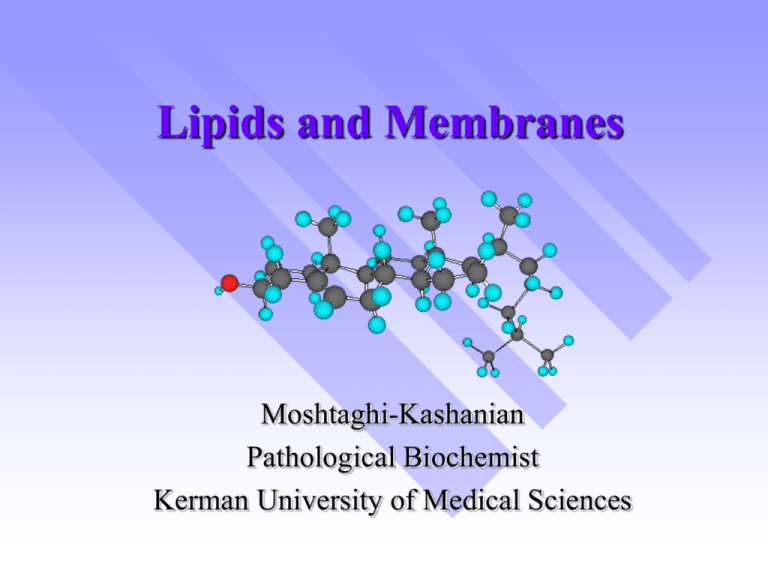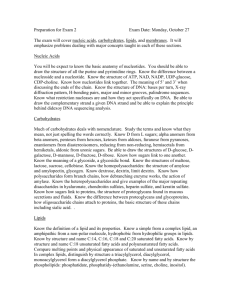lipids
advertisement

Lipids and Membranes Moshtaghi-Kashanian Pathological Biochemist Kerman University of Medical Sciences Lipids • Lipids: a heterogeneous class of naturally occurring organic compounds classified together on the basis of common solubility properties • They are insoluble in water, but soluble in aprotic organic solvents, including diethyl ether, chloroform, methylene chloride, and acetone • Lipids include • triacylglycerols, phosphodiacylglycerols, sphingolipids, glycolipids, lipid-soluble vitamins, and prostaglandins • cholesterol, steroid hormones, and bile acids Fatty Acids • Fatty acid: a long, un-branched chain carboxylic acid, most commonly of 12 - 20 carbons, derived from hydrolysis of animal fats, vegetable oils, or phosphodiacylglycerols of biological membranes • In the shorthand notation for fatty acids • the number of carbons and the number of double bonds in the chain are shown by two numbers, separated by a colon Fatty Acids Fatty Acids Among the fatty acids most abundant in plants and animals • Nearly all have an even number of carbon atoms, most between 12 and 20, in an un-branched chain • The three most abundant are palmitic (16:0), stearic acid (18:0), and oleic acid (18:1) • In most unsaturated fatty acids, the cis isomer predominates; the trans isomer is rare • unsaturated fatty acids have lower melting points than their saturated counterparts; the greater the degree of unsaturation, the lower the melting point Triacylglycerols • Triacylglycerol (triglyceride): an ester of glycerol with three fatty acids • natural soaps are prepared by boiling triglycerides (animal fats or vegetable oils) with NaOH, in a reaction called saponification (Latin, sapo, soap Soaps • Soaps form water-insoluble salts when used in water containing Ca(II), Mg(II), and Fe(III) ions (hard water) Phosphoacylglycerols • Phosphoacylglycerols (phosphoglycerides) are the second most abundant group of naturally occurring lipids • found almost exclusively in plant and animal membranes, which typically consist of 40% -50% phosphoacylglycerols and 50% - 60% proteins • the most abundant phosphoacylglycerols are derived from phosphatidic acid, a molecule in which glycerol is esterified with two molecules of fatty acid and one of phosphoric acid • the three most abundant fatty acids in phosphatidic acids are palmitic acid (16:0), stearic acid (18:0), and oleic acid (18:1) Phosphoacylglycerols • A phosphatidic acid • further esterification with a low-molecular weight alcohol gives a phosphoacylglycerol • among the most common of these low-molecular Phosphoacylglycerols Phosphoacylglycerols Phosphoacylglycerols • A lecithin Waxe • Esters of long-chain fatty acids and alcohols • from the Old English word weax = honeycom Sphingolipids Glycolipids • Glycolipid: a compound in which a carbohydrate is bound to an -OH of the lipid many glycolipids are derived from ceramides Steroids • Steroids: a group of plant and animal lipids that have this tetracyclic ring structure • The features common to the ring system of most naturally occurring steroids are illustrated on the next screen Steroids Cholesterol Androgens • Androgens - male sex hormones • synthesized in the testes • responsible for the development of male secondary sex characteristics Androgens Estrogens • Estrogens - female sex hormones • synthesized in the ovaries • responsible for the development of female secondary sex characteristics and control of the menstrual cycle Estrogens Biological Membranes • In aqueous solution, phosphoglycerides spontaneously form into a lipid bilayer, with a backto-back arrangement of lipid monolayers • polar head are in contact with the aqueous environment • nonpolar tails are buried within the bilayer • the major force driving the formation of lipid bilayers is hydrophobic interaction • the arrangement of hydrocarbon tails in the interior can be rigid (if rich in saturated fatty acids) or fluid (if rich in unsaturated fatty acids) Biological Membranes • the presence of cholesterol increases rigidity • with heat, membranes become more disordered; the transition temperature is higher for more rigid membranes; it is lower for less rigid membranes Membrane Proteins • Functions: transport substances across membranes, receptor sites, and sites of enzyme catalysis • Peripheral proteins • bound by electrostatic interactions • can be removed by raising the ionic strength • Integral proteins • bound tightly to the interior of the membrane • removed by treatment with detergents or ultrasonification • removal generally denatures them Fluid Mosaic Model • Fluid: there is lateral motion of components in the membrane; • proteins, for example, “float” in the membrane and can move along its plane • Mosaic:components in the membrane exist side-by-side as separate entities • the basic structure is that of a lipid bilayer with proteins, glycolipids, and steroids such as cholesterol embedded in it • no complexes, as for example, lipid-protein complexes, are formed Membrane Transport • Passive transport • driven by a concentration gradient • simple diffusion: a molecule or ion moves through an opening created by a channel protein • facilitated diffusion: molecule or ion is carried across a membrane by a carrier protein • Active transport • a molecule or ion is moved against a concentration gradient • see the Na+/K+ ion pump Membrane Receptors • Membrane receptors • generally oligomeric proteins • binding of a biologically active substance to a receptor initiates an action within the cell Lipid-Soluble Vitamins • Vitamins are divided into two broad classes on the basis of their solubility . Those that are water-soluble . Those that are lipid-soluble (and hence classified as lipids) The lipid-soluble vitamins include A, D, E, and K Prostaglandins • Prostaglandins: a family of compounds that have the 20-carbon skeleton of prostanoic acid Prostaglandins • Prostaglandins are not stored in tissues as such, but are synthesized from membranebound 20-carbon polyunsaturated fatty acids in response to specific physiological triggers • one such polyunsaturated fatty acid is arachidonic acid Prostaglandins • among those synthesized from arachidonic acid are Prostaglandins • Research on the involvement of PGs in reproductive physiology has produced several clinically useful derivatives • 15-Methyl-PGF2a is used as a therapeutic abortifacient Prostaglandins • the PGE1 analog, misoprostol, is used for prevention of ulceration associated with the use of aspirin-like non-steroidal antiinflammatory drugs (NSAIDs) Leukotrienes • Leukotrienes: derived from arachidonic acid • found in white blood cells (leukocytes) • an important property is constriction of smooth muscles, especially in the lungs Thromboxanes • derived from arachidonic acid • contain a four-membered cyclic ether within a six-membered ring induce platelet aggregation and smooth muscle contraction








